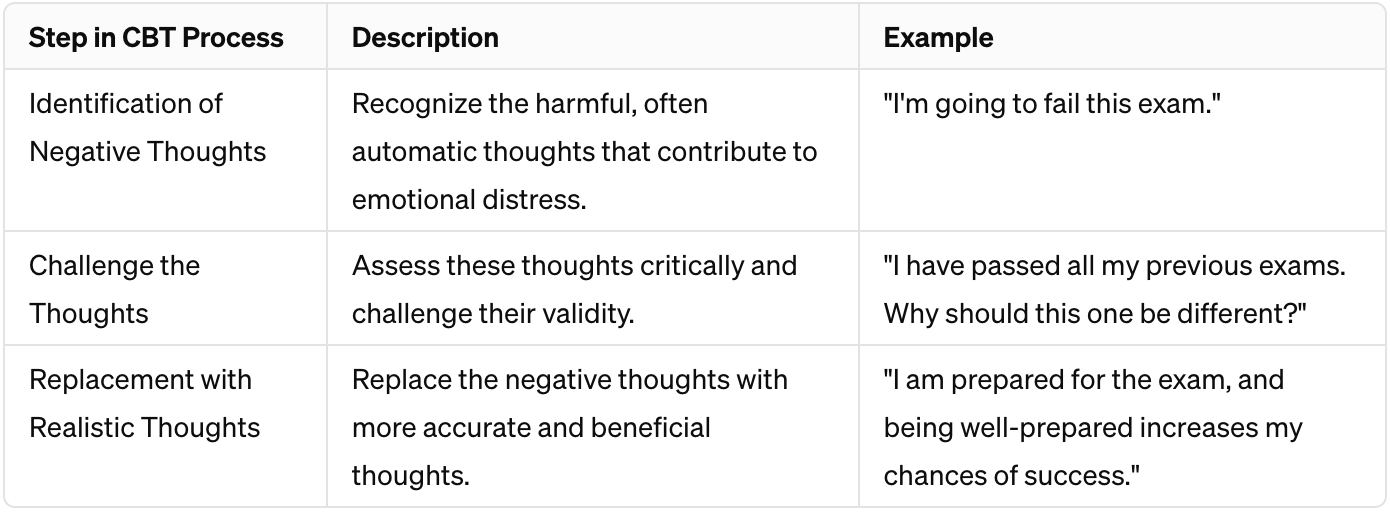Relieving and Managing Anxiety and Depression using Cognitive Behavioral Therapy
In the hustle and bustle of daily life, feelings of anxiety and depression can often seem like uninvited guests that refuse to leave, gradually eating away at our inner peace and ability to function. These mental health issues can be as crippling as any physical ailment, making even simple tasks seem daunting. Recognizing this struggle is the first step toward reclaiming your life, and therapy, particularly Cognitive Behavioral Therapy (CBT), offers a beacon of hope.
The journey to a therapist's office, however, isn't always an easy one. Barriers such as time constraints, financial limitations, or even the stigma associated with seeking mental health help can deter many. Moreover, the thought of opening up to a stranger about personal issues can be daunting. Fortunately, the principles of many therapeutic practices, including CBT, can be applied independently at home, providing a viable option for those unable or hesitant to access professional help directly.
Understanding Why Cognitive Behavioral Therapy is Effective
CBT is a structured, short-term, problem-focused form of behavioral treatment that helps people see the difference between beliefs, thoughts, and feelings, and free them from unhelpful patterns of behavior. This therapy operates on the principle that our thoughts, feelings, and behaviors are interconnected and that changing one can change the others.
Many people with depression are skeptical that "just thinking positively" can affect their mental health. However, CBT isn't just about thinking positively—it's about thinking more clearly.
What’s more is there is research showing that consistently practicing CBT techniques can actually help rewire the brain, promoting healthier thought patterns and behaviors that stick! It rewires the brain through a process called neuroplasticity. Neuroplasticity, or the brain's ability to reorganize itself by forming new neural connections, plays a crucial role in this. Each time we practice a new type of behavior or rethink a situation to reduce anxiety or stress, our neural pathways adjust to accommodate these new ways of thinking. Over time, these pathways become stronger, making the healthier thought patterns more automatic. Moreover, research suggests that CBT can lead to significant changes in brain function and structure, influencing neurotransmitters related to mood regulation, such as serotonin and dopamine, which are often targeted by antidepressant medications.
The Science Behind CBT and Its Effects on the Brain
Don’t believe me yet? Here are a few key studies and findings that show how CBT has actually led to a neurological change:
Social Anxiety and Amygdala Changes: Research involving participants with social anxiety disorder demonstrated significant changes in brain structure and function after undergoing CBT. Functional Magnetic Resonance Imaging (fMRI) scans showed that the amygdala, a region associated with processing fear and threats, decreased in volume and sensitivity. This reduction corresponded with a decrease in anxiety symptoms, illustrating how CBT can physically alter brain regions associated with emotional responses (CPD Online College).
Psychosis and Strengthened Brain Connections: A study conducted at Kings College London explored the effects of CBT on patients with psychosis. The results indicated increased brain activity and strengthened connections between the amygdala and the prefrontal cortex, the latter being responsible for rational thinking and decision-making. These changes helped patients better distinguish between actual and perceived threats, reducing their paranoia and improving their connection with reality (Living Well Counselling Services).
Depression and Neurotransmitter Regulation: CBT has also been shown to help regulate neurotransmitters such as dopamine, serotonin, and norepinephrine. By changing negative thought patterns and behaviors, CBT can influence these chemical pathways, thereby improving mood and emotional well-being. This process can be observed through changes in brain activity patterns in individuals treated with CBT (ChildPsychsMelb).
Here’s a simplified chart showing how CBT works:
The CBT Process and Pattern of Thinking
Charting the Course with CBT
Implementing CBT into your daily routine can start with recognizing triggers and writing down the thoughts associated with them. For instance:
Reframing thoughts using Cognitive Behavioral Therapy (CBT)
The Impact of CBT
Studies consistently show that CBT can significantly reduce the symptoms of anxiety and depression. Research indicates that about 70% of people with these conditions benefit from this type of therapy. CBT's structured, short-term, and problem-focused approach makes it an effective tool for anyone looking to manage these challenges.
While anxiety and depression medications are commonly prescribed and can be effective for severe cases, they are not without their drawbacks. Long-term use of such medications can lead to dependency or might have other adverse effects. Moreover, medication often addresses the symptoms rather than the root cause of emotional distress. CBT, on the other hand, empowers individuals by giving them the tools to control their thoughts, which can lead to lasting mental health improvements.
Embarking on Your CBT Journey
Incorporating CBT into your routine doesn't require dramatic changes. It begins with the awareness that your thoughts influence your feelings and behaviors. Start small: note down negative thoughts throughout the day and challenge them with rational alternatives. Resources like books, online courses, and mobile applications can guide you through the CBT process, making the practice accessible and manageable from the comfort of your home.
Remember, choosing to engage with CBT techniques is a sign of strength, not weakness. It’s about taking control of your life’s narrative and rewriting it into one of resilience and optimism. Whether you’re navigating this path with the help of a therapist or on your own, every step taken is a step toward a more joyful, fulfilling life. With commitment and patience, Cognitive Behavioral Therapy can be a transformative force, turning your darkest moments into opportunities for profound personal growth.


